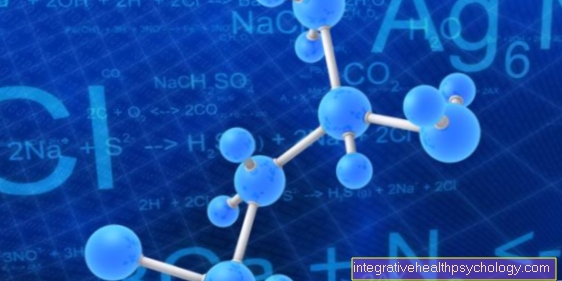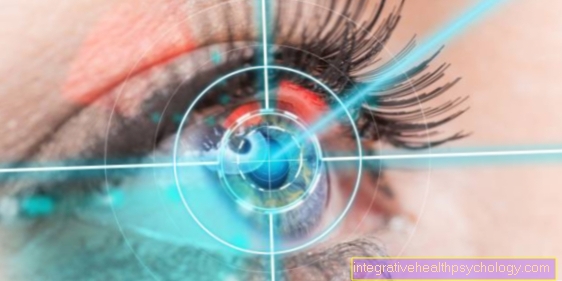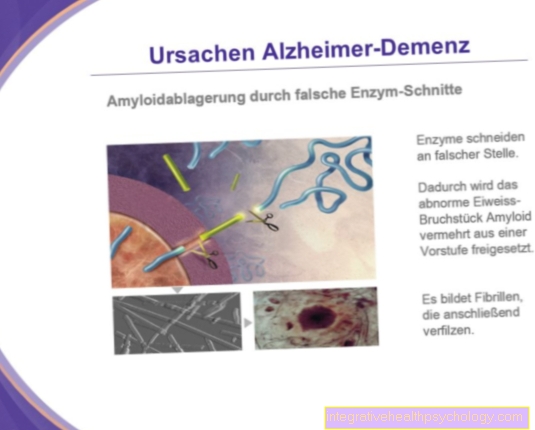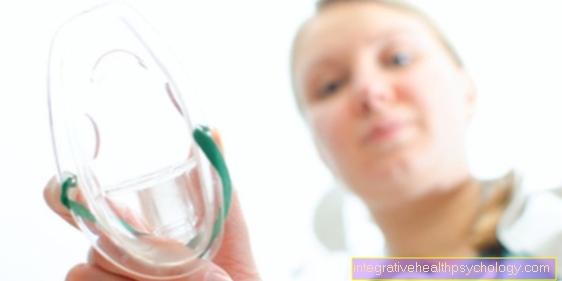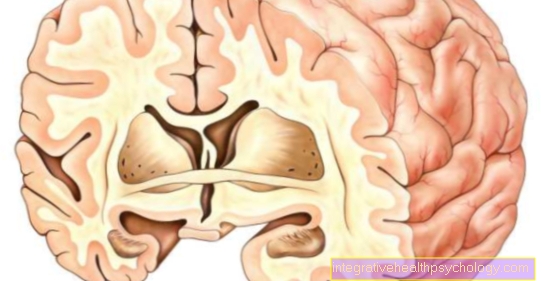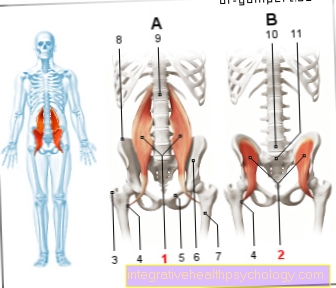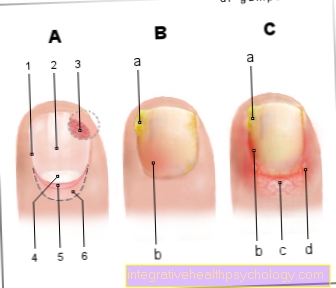Circulatory problems in the hands
definition
Circulatory disorders of the hands and fingers are common. Many people know this; cold hands, pale skin, hands asleep, painful tingling in the fingers. All of these symptoms can indicate circulatory problems in the hands. The causes are varied. Raynaud's syndrome is relatively well known. But arteriosclerosis, acute vascular occlusions due to thrombosis or embolism, as well as heart diseases can trigger circulatory disorders in the hands. It is important to find the cause and treat it. Then circulatory disorders in the hands and fingers have a good prognosis.
Read more on the topic: Arteriosclerosis

Causes of circulatory disorders in the hands
Circulatory disorders in the hands can have many causes. One possibility for a circulatory disorder in the hands is Raynaud's syndrome. This disease is popularly known as white finger disease. A sudden cramping of the blood vessels causes the blood to flow to the hands to almost completely stop for a short time.
A hardening of the arteries can also lead to circulatory disorders in the hands, just as an embolism (a blood clot that is carried further by the bloodstream) can cause an acute vascular occlusion. In the context of neurological diseases such as multiple sclerosis or carpal tunnel syndrome, circulatory disorders can also occur in the hands.
This also applies to medications, such as the pill or certain chemotherapy drugs.
You might also be interested in the topic: Causes of atherosclerosis
Smoking as a cause of circulatory disorders
Smoking always damages the blood vessels. Nicotine consumption can cause circulatory disorders throughout the body. Smokers have a significantly increased risk of a heart attack (circulatory disorders in the heart). But the risk of circulatory disorders in the hands is also increased. Usually these then occur in the context of arteriosclerosis.
Irrespective of arteriosclerosis, Raynaud's syndrome causes spasmodic narrowing of the blood vessels (Vasospasm). The cause of Raynaud's syndrome has not yet been fully researched. However, it is known that there are certain triggers for vasospasm. In addition to cold and stress, this also includes smoking.
Read more on the topic: Risk factors for arteriosclerosis
Raynaud's syndrome as the cause
Raynaud's syndrome is a typical cause of circulatory disorders in the hands. Sudden spasms of the arterial blood vessels occur here for an unexplained cause (Vasospasm) in the fingers and toes. Possible triggers are:
- Cold,
- mental stress or
- hormonal disorders
Women are affected more often than men. The tricolor phenomenon is typical of Raynaud's syndrome. The fingers are initially white due to the sudden occlusion of the blood vessels. As they progress, they turn blue. If the spasm of the blood vessels disappears again, there is a reactive increase in blood flow and the hands appear clearly reddened.
Read more about that here: Raynaud's Syndrome
Therapy for circulatory disorders in the hands
Circulatory disorders in the hands can usually be treated quite well. It is crucial to determine the cause of the circulatory disorders and to treat them.
In Raynaud's syndrome, for example, this means that triggering factors such as stress and cold should be avoided. This generally applies to circulatory disorders; hands should always be kept warm. In worse cases, drugs such as alpha-receptor blockers, calcium antagonists or prostaglandin analogues can be used in Raynaud's syndrome.
In the case of circulatory disorders due to arteriosclerosis, the risk factors that lead to the development of arteriosclerosis should be treated. This includes good blood pressure and blood sugar control.
If the circulatory disorders occur in the context of neurological diseases, these should be treated.
Sometimes these circulatory disorders are also triggered by working with jackhammers. These vibrations lead to vasospasm. If you have circulatory problems in your hands, you should avoid such work.
Read more on the topic: Therapy of circulatory disorders
Home remedies
There are many home remedies to stimulate the blood circulation in the hands again and thus counteract circulatory disorders. Cold and warm hand baths are particularly recommended. Brush massages are also very good at promoting blood circulation. They open the blood vessels in the skin and blood can better circulate through the hands. Furthermore, you should always keep your hands warm. Studies have shown that blood circulation is better at higher temperatures.
There are also numerous herbal home remedies that can be used against circulatory disorders. One example is rosemary. It stimulates the circulation. Garlic and hawthorn are recommended for the treatment of atherosclerosis and they provide good circulation by cleaning the blood vessels.
Eating a healthy diet is also crucial for blood flow in your hands. This also applies to a sufficient amount of drinking. This is the only way to keep the blood supple. Nicotine should definitely be avoided. Smoking damages blood vessels all over the body.
Read more about here: Home remedies for circulatory disorders
Prognosis of circulatory disorders
The prognosis for circulatory disorders in the hands is usually good. However, it always depends on the cause of the circulatory disorders. With Raynaud's syndrome, the prognosis is usually very good, as it is an often very disturbing but nevertheless rather harmless disease. One should avoid the triggers. This usually prevents vasospasm (spasms of the blood vessels) from occurring.
Circulatory disorders caused by arteriosclerosis cannot be cured. However, if the appropriate risk factors are treated, the disease does not worsen any further.
You might also be interested in the topic: Medicines for circulatory disorders
Course of disease
The course of the disease of circulatory disorders in the hands depends on their cause. Circulatory disorders caused by arteriosclerosis can lead to problems in the long run.
The poor circulation can cause complications. For example, even smaller wounds do not heal well. If these wounds then become infected and the infection cannot be controlled and spreads to the bone, then often only the amputation remains. However, circulatory disorders in the hands are often not that serious.
Read more on the topic: Treatment of atherosclerosis
Which doctor treats this?
The first point of contact for circulatory disorders in the hands is certainly the family doctor. He can then determine what type of circulatory disorders are present and whether the patient needs to be treated by a specialist. Another point of contact for circulatory disorders in the hands is the angiologist. He is a specialist in vascular diseases. It can treat Raynaud's syndrome. This is also treated by the specialists in rheumatology.
I recognize a circulatory disorder in the hands from these symptoms
Circulatory disorders in the hands are not uncommon. Many people are affected by it every now and then. The following symptoms can be used to tell whether you yourself suffer from circulatory disorders in the hands. The temperature of the hands provides an initial indication of circulatory disorders. In affected patients, these are often cold. The color also changes. The poor blood circulation makes the hands look very pale, sometimes almost white. However, they can also become more bluish in color.
Circulatory disorders are often accompanied by painful abnormal sensations such as tingling or numbness.
Read about this too: Can a tingling sensation indicate a circulatory disorder?
Pain
Circulatory disorders in the hands are common and very uncomfortable for those affected. They are often accompanied by discomfort and pain. If the hands or fingers are no longer supplied with sufficient blood, their cells are no longer supplied with sufficient oxygen.
If such a lack of oxygen persists, the cells die. Therefore, if there is a lack of oxygen, they sound the alarm early on. This is then perceived as a painful pull. Tingling and numbness also occur when nerve cells are no longer well supplied with blood.
Blue fingers
Blue fingers are a common symptom of circulatory problems in the hands. These occur primarily in so-called Raynaud's syndrome. For reasons unknown, the arteries contract convulsively. This interrupts the transport of fresh oxygen-rich blood to the hands. The skin looks pale. The deoxygenated blood that flows through the veins appears bluish through the skin. Other accompanying symptoms, in addition to blue fingers, are painful paresthesia and cold hands.
White fingers
In the context of circulatory disorders in the hands, white, cold fingers are often noticed. This can be explained by the fact that warm, oxygen-rich blood is no longer transported through the arteries to the fingers. Due to the lack of blood circulation, the skin appears pale, sometimes even almost whitish. This is always accompanied by pain. The cells in the hands and fingers register the lack of blood flow and the resulting lack of oxygen. They react to this potential tissue damage by sending pain stimuli to the brain.
How is a circulatory disorder diagnosed?
In order to diagnose circulatory disorders in the hands, a medical history must first be taken (anamnese) important. Raynaud's syndrome can usually be recognized by the typical description of the symptoms. Atherosclerotic circulatory disorders indicate concomitant diseases such as:
- High blood pressure,
- Diabetes mellitus and one
- Lipid metabolism disorder
down.
The physical examination follows after taking the medical history. The doctor will do an Allen test. One by one, it compresses the arteries that supply blood to the hand. A damaged vessel cannot transport enough blood for the hand. If the doctor prevents the healthy artery from compensating for the lack of blood flow by manually applying pressure, the hand often loses its color noticeably. This is a clear indication of a circulatory disorder. Further laboratory or possibly imaging examinations can follow.



